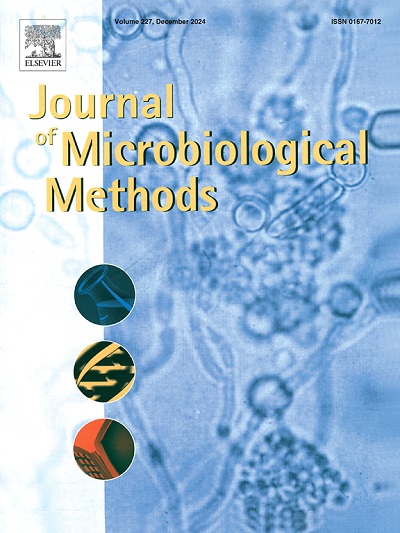新型高效谷氨酰胺棒状杆菌基因表达系统的开发
IF 1.9
4区 生物学
Q4 BIOCHEMICAL RESEARCH METHODS
引用次数: 0
摘要
一个理想的用于工业酶生产的微生物基因表达系统应该具有功能互补的选择标记,具有成本效益的诱导剂和细胞外蛋白分泌能力。本研究采用CRISPR-Cpf1基因编辑技术,通过删除丙氨酸外消旋酶编码基因alr和谷氨酸外消旋酶编码基因murI,将枯草芽孢杆菌阿拉伯糖相关化合物过溶酶编码基因araE整合到染色体中,构建谷氨酸棒状杆菌(棒状杆菌)宿主菌株C. glutamicum Δalr∷araE ΔmurI。构建了以alr为选择标记的两种分泌型表达载体pAU30S (sec型)和pAU30T (tat型),T7转录系统转录靶基因,枯草芽孢杆菌AraR-ORA1/ORA2阴性对照系统控制基因转录。以嗜脂热地杆菌α-淀粉酶AmyF作为报告蛋白,检测l -阿拉伯糖诱导的基因表达系统C. glutamicum/pAU30S和C. glutamicum Δalr∷araE ΔmurI/pAU30T的适用性。透明圈调查、SDS-PAGE和淀粉酶活性分析结果表明,重组AmyF能够高效表达并以活性形式完全分泌到培养基中。C. glutamicum Δalr∷araE ΔmurI/pAU30S和C. glutamicum Δalr∷araE ΔmurI/pAU30T系统是高效的基因表达平台,适用于工业酶的分泌生产。本文章由计算机程序翻译,如有差异,请以英文原文为准。
Development of novel and efficient Corynebacterium glutamicum gene expression systems for industrial enzyme production
An ideal microbial gene expression system for industrial enzyme production should possess a function complementary selection marker, a cost-effective inducer, and the ability for extracellular protein secretion. In this study,we employed CRISPR-Cpf1 gene editing technology to construct an engineered Corynebacterium glutamicum host strain, C. glutamicum Δalr∷araE ΔmurI, by deleting the alanine racemase-encoding gene alr and the glutamate racemase-encoding gene murI, and by integrating the Bacillus subtilis arabinose-related compounds permease-encoding gene araE into the chromosome. The two secretion-type expression vectors pAU30S (Sec-type) and pAU30T (Tat-type) that both employ alr as selection marker, the T7 transcription system to transcribe target genes, and the B. subtilis AraR-ORA1/ORA2 negative control system to control gene transcription, were constructed. The α-amylase AmyF from Geobacillus stearothermophilus was used as reporter protein to test the applicability of the L-arabinose-induced gene expression systems C. glutamicum/pAU30S and C. glutamicum Δalr∷araE ΔmurI/pAU30T. The results of transparent circle investigation, SDS-PAGE and amylase activity analysis demonstrated that the recombinant AmyF was efficiently expressed and completely secreted into the culture medium in its active form. The C. glutamicum Δalr∷araE ΔmurI/pAU30S and C. glutamicum Δalr∷araE ΔmurI/pAU30T systems represent highly efficient gene expression platforms suitable for the secretory production of industrial enzymes.
求助全文
通过发布文献求助,成功后即可免费获取论文全文。
去求助
来源期刊

Journal of microbiological methods
生物-生化研究方法
CiteScore
4.30
自引率
4.50%
发文量
151
审稿时长
29 days
期刊介绍:
The Journal of Microbiological Methods publishes scholarly and original articles, notes and review articles. These articles must include novel and/or state-of-the-art methods, or significant improvements to existing methods. Novel and innovative applications of current methods that are validated and useful will also be published. JMM strives for scholarship, innovation and excellence. This demands scientific rigour, the best available methods and technologies, correctly replicated experiments/tests, the inclusion of proper controls, calibrations, and the correct statistical analysis. The presentation of the data must support the interpretation of the method/approach.
All aspects of microbiology are covered, except virology. These include agricultural microbiology, applied and environmental microbiology, bioassays, bioinformatics, biotechnology, biochemical microbiology, clinical microbiology, diagnostics, food monitoring and quality control microbiology, microbial genetics and genomics, geomicrobiology, microbiome methods regardless of habitat, high through-put sequencing methods and analysis, microbial pathogenesis and host responses, metabolomics, metagenomics, metaproteomics, microbial ecology and diversity, microbial physiology, microbial ultra-structure, microscopic and imaging methods, molecular microbiology, mycology, novel mathematical microbiology and modelling, parasitology, plant-microbe interactions, protein markers/profiles, proteomics, pyrosequencing, public health microbiology, radioisotopes applied to microbiology, robotics applied to microbiological methods,rumen microbiology, microbiological methods for space missions and extreme environments, sampling methods and samplers, soil and sediment microbiology, transcriptomics, veterinary microbiology, sero-diagnostics and typing/identification.
 求助内容:
求助内容: 应助结果提醒方式:
应助结果提醒方式:


